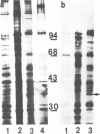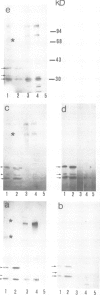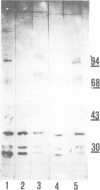Abstract
Proteins can be extracted from the slime sheath of Dictyostelium discoideum slugs by denaturing agents. A subset of these proteins is also released by cellulase digestion of the sheath, implying that protein-protein and protein-cellulose interactions are involved in sheath protein retention. It seems probable that the cellulose-associated sheath proteins are also associated with the cellulose of mature stalk cells. Monoclonal antibodies directed against sheath demonstrate extensive sharing of antigenic determinants between sheath proteins and a limited degree of antigenic sharing between sheath and slug cell proteins. All of the proteins recognised by these monoclonal antibodies are developmentally regulated. These results are discussed in terms of the structure of the sheath and its possible role(s) in D. discoideum development.
Keywords: Dictyostelium discoideum, extracellular matrix, monoclonal antibody, protein modification, slime sheath
Full text
PDF
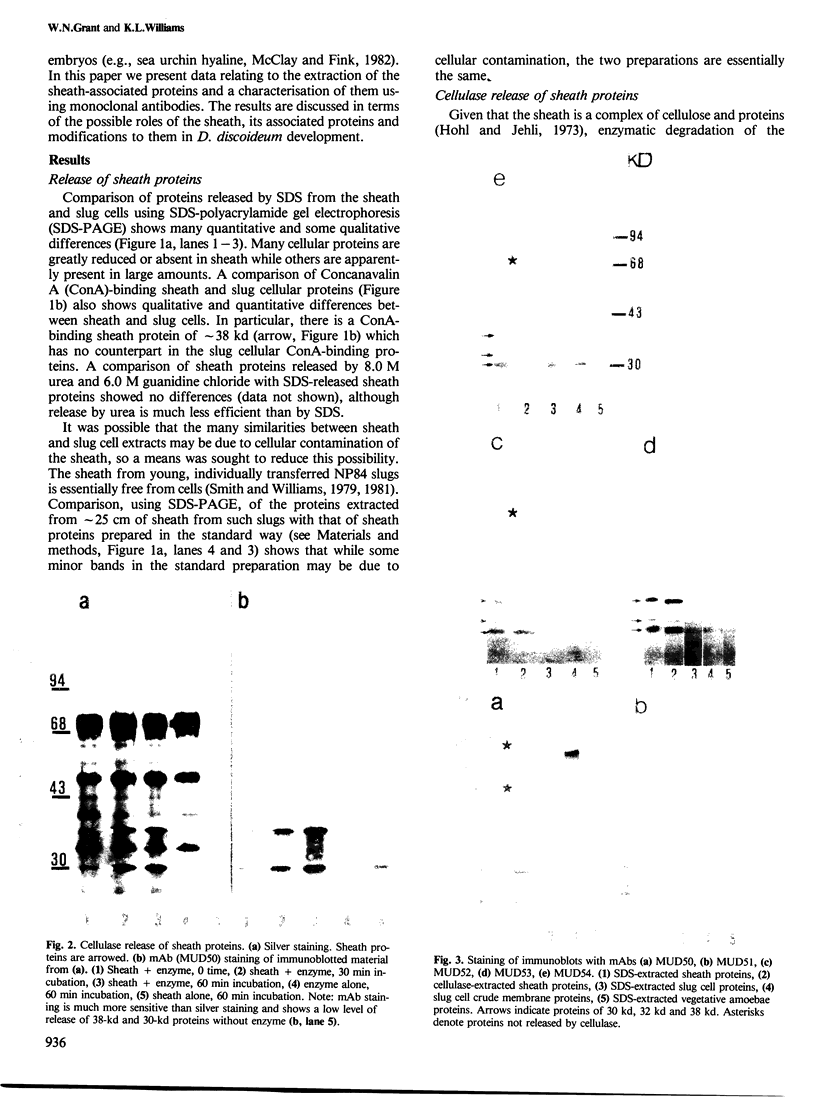
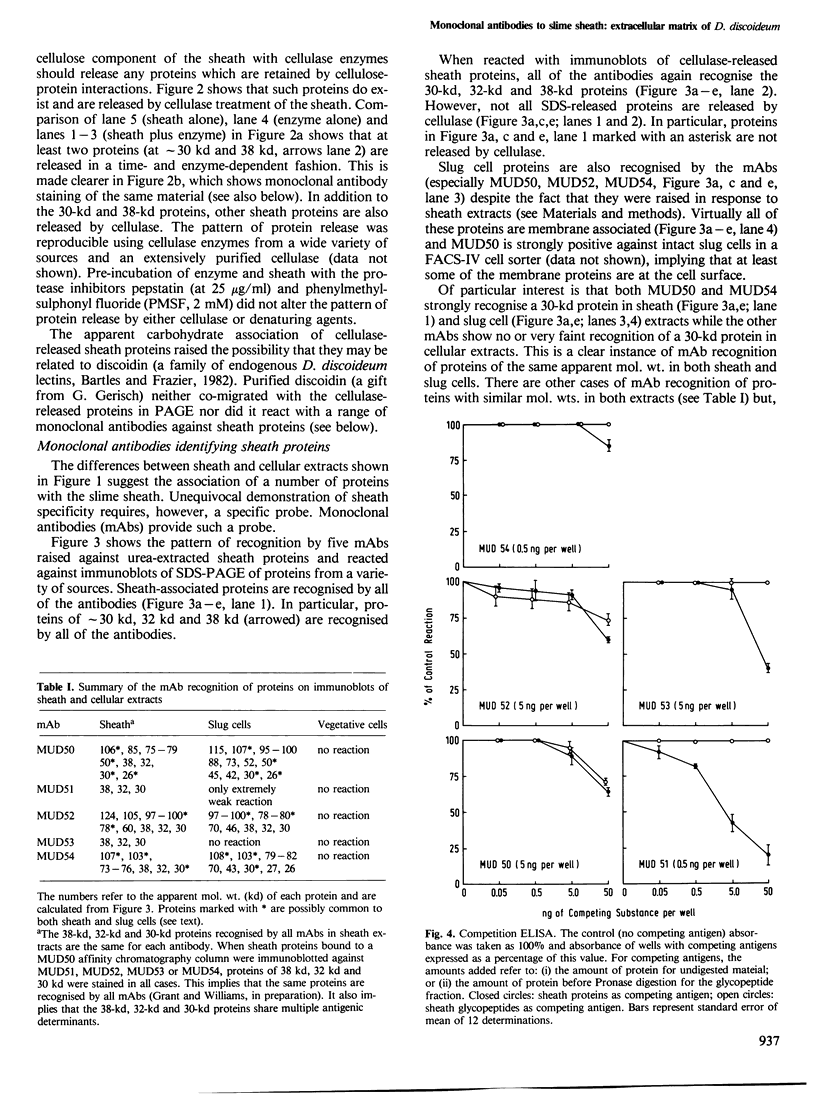
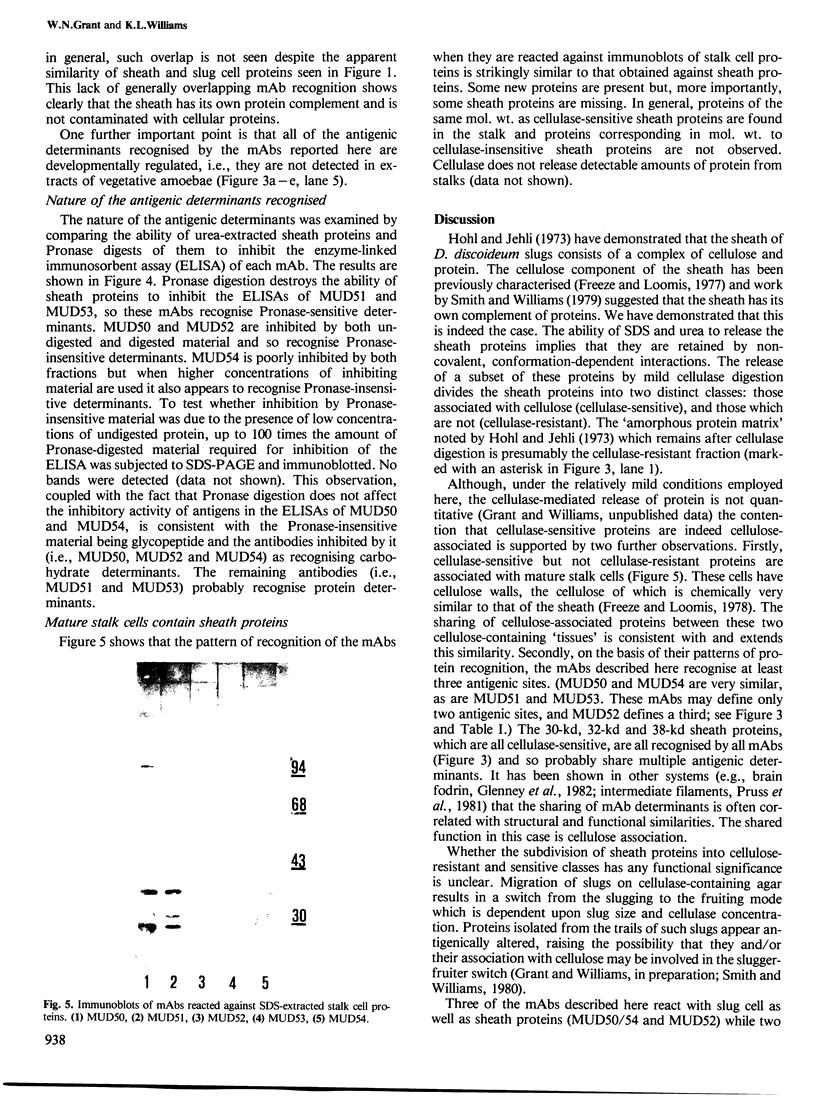
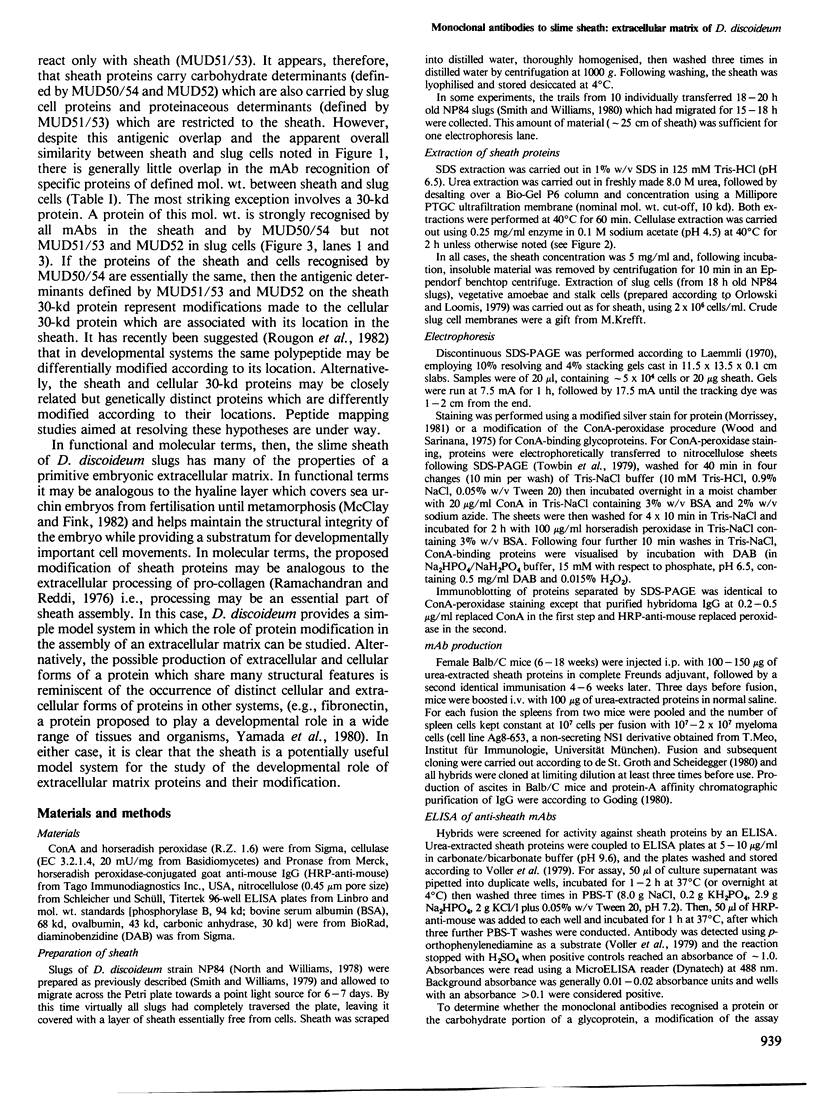

Images in this article
Selected References
These references are in PubMed. This may not be the complete list of references from this article.
- Ashworth J. M. Cell development in the cellular slime mould Dictyostelium discoideum. Symp Soc Exp Biol. 1971;25:27–49. [PubMed] [Google Scholar]
- Bartles J. R., Frazier W. A., Rosen S. D. Slime mold lectins. Int Rev Cytol. 1982;75:61–99. doi: 10.1016/s0074-7696(08)61002-5. [DOI] [PubMed] [Google Scholar]
- Farnsworth P. A., Loomis W. F. A barrier to diffusion in pseudoplasmodia of Dictyostelium discoideum. Dev Biol. 1974 Nov;41(1):77–83. doi: 10.1016/0012-1606(74)90284-x. [DOI] [PubMed] [Google Scholar]
- Farnsworth P. A., Loomis W. F. A gradient in the thickness of the surface sheath in pseudoplasmodia of Dictyostelium discoideum. Dev Biol. 1975 Oct;46(2):349–357. doi: 10.1016/0012-1606(75)90111-6. [DOI] [PubMed] [Google Scholar]
- Freeze H., Loomis W. F. Chemical analysis of stalk components of Dictostelium discoideum. Biochim Biophys Acta. 1978 Apr 3;539(4):529–537. doi: 10.1016/0304-4165(78)90086-7. [DOI] [PubMed] [Google Scholar]
- Freeze H., Loomis W. F. Isolation and characterization of a component of the surface sheath of Dictyostelium discoideum. J Biol Chem. 1977 Feb 10;252(3):820–824. [PubMed] [Google Scholar]
- Glenney J. R., Jr, Glenney P., Weber K. Erythroid spectrin, brain fodrin, and intestinal brush border proteins (TW-260/240) are related molecules containing a common calmodulin-binding subunit bound to a variant cell type-specific subunit. Proc Natl Acad Sci U S A. 1982 Jul;79(13):4002–4005. doi: 10.1073/pnas.79.13.4002. [DOI] [PMC free article] [PubMed] [Google Scholar]
- Goding J. W. Antibody production by hybridomas. J Immunol Methods. 1980;39(4):285–308. doi: 10.1016/0022-1759(80)90230-6. [DOI] [PubMed] [Google Scholar]
- Hohl H. R., Jehli J. The presence of cellulose microfibrils in the proteinaceous slime track of Dictyostelium discoideum. Arch Mikrobiol. 1973 Aug 21;92(3):179–187. doi: 10.1007/BF00411198. [DOI] [PubMed] [Google Scholar]
- Laemmli U. K. Cleavage of structural proteins during the assembly of the head of bacteriophage T4. Nature. 1970 Aug 15;227(5259):680–685. doi: 10.1038/227680a0. [DOI] [PubMed] [Google Scholar]
- Loomis W. F., Jr Role of the surface sheath in the control of morphogenesis in Dictyostelium discoideum. Nat New Biol. 1972 Nov 1;240(96):6–9. doi: 10.1038/newbio240006a0. [DOI] [PubMed] [Google Scholar]
- McClay D. R., Fink R. D. Sea urchin hyalin: appearance and function in development. Dev Biol. 1982 Aug;92(2):285–293. doi: 10.1016/0012-1606(82)90175-0. [DOI] [PubMed] [Google Scholar]
- Morrissey J. H. Silver stain for proteins in polyacrylamide gels: a modified procedure with enhanced uniform sensitivity. Anal Biochem. 1981 Nov 1;117(2):307–310. doi: 10.1016/0003-2697(81)90783-1. [DOI] [PubMed] [Google Scholar]
- Newell P. C., Telser A., Sussman M. Alternative developmental pathways determined by environmental conditions in the cellular slime mold Dictyostelium discoideum. J Bacteriol. 1969 Nov;100(2):763–768. doi: 10.1128/jb.100.2.763-768.1969. [DOI] [PMC free article] [PubMed] [Google Scholar]
- Orlowski M., Loomis W. F. Plasma membrane proteins of Dictyostelium: the spore coat proteins. Dev Biol. 1979 Aug;71(2):297–307. doi: 10.1016/0012-1606(79)90171-4. [DOI] [PubMed] [Google Scholar]
- Pruss R. M., Mirsky R., Raff M. C., Thorpe R., Dowding A. J., Anderton B. H. All classes of intermediate filaments share a common antigenic determinant defined by a monoclonal antibody. Cell. 1981 Dec;27(3 Pt 2):419–428. doi: 10.1016/0092-8674(81)90383-4. [DOI] [PubMed] [Google Scholar]
- Rougon G., Deagostini-Bazin H., Hirn M., Goridis C. Tissue- and developmental stage-specific forms of a neural cell surface antigen linked to differences in glycosylation of a common polypeptide. EMBO J. 1982;1(10):1239–1244. doi: 10.1002/j.1460-2075.1982.tb00019.x. [DOI] [PMC free article] [PubMed] [Google Scholar]
- SHAFFER B. M. CELL MOVEMENT WITHIN AGGREGATES OF THE SLIME MOULD DICTYOSTELIUM DISCOIDEUM REVEALED BY SURFACE MARKERS. J Embryol Exp Morphol. 1965 Feb;13:97–117. [PubMed] [Google Scholar]
- Schindler J., Sussman M. Ammonia determines the choice of morphogenetic pathways in Dictyostelium discoideum. J Mol Biol. 1977 Oct 15;116(1):161–169. doi: 10.1016/0022-2836(77)90124-3. [DOI] [PubMed] [Google Scholar]
- Smith E., Williams K. L. Evidence for tip control of the 'slug/fruit' switch in slugs of Dictyostelium discoideum. J Embryol Exp Morphol. 1980 Jun;57:233–240. [PubMed] [Google Scholar]
- Smith E., Williams K. L. The age-dependent loss of cells from the rear of Dictyostelium discoideum slug is not tip controlled. J Embryol Exp Morphol. 1981 Feb;61:61–67. [PubMed] [Google Scholar]
- Sussman M., Schindler J., Kim H. "Sluggers", a new class of morphogenetic mutants of D. discoideum. Exp Cell Res. 1978 Oct 1;116(1):217–227. doi: 10.1016/0014-4827(78)90078-2. [DOI] [PubMed] [Google Scholar]
- Towbin H., Staehelin T., Gordon J. Electrophoretic transfer of proteins from polyacrylamide gels to nitrocellulose sheets: procedure and some applications. Proc Natl Acad Sci U S A. 1979 Sep;76(9):4350–4354. doi: 10.1073/pnas.76.9.4350. [DOI] [PMC free article] [PubMed] [Google Scholar]
- Watts D. J., Treffery T. E. Incorporation of N-acetylglucosamine into the slime sheath of the cellular slime mould Dictyostelium discoideum. FEBS Lett. 1975 Apr 1;52(2):262–264. doi: 10.1016/0014-5793(75)80820-9. [DOI] [PubMed] [Google Scholar]
- Wood J. G., Sarinana F. O. The staining of sciatic nerve glycoproteins on polyacrylamide gels with concanavalin A-peroxidase. Anal Biochem. 1975 Nov;69(1):320–322. doi: 10.1016/0003-2697(75)90597-7. [DOI] [PubMed] [Google Scholar]
- de StGroth S. F., Scheidegger D. Production of monoclonal antibodies: strategy and tactics. J Immunol Methods. 1980;35(1-2):1–21. doi: 10.1016/0022-1759(80)90146-5. [DOI] [PubMed] [Google Scholar]



